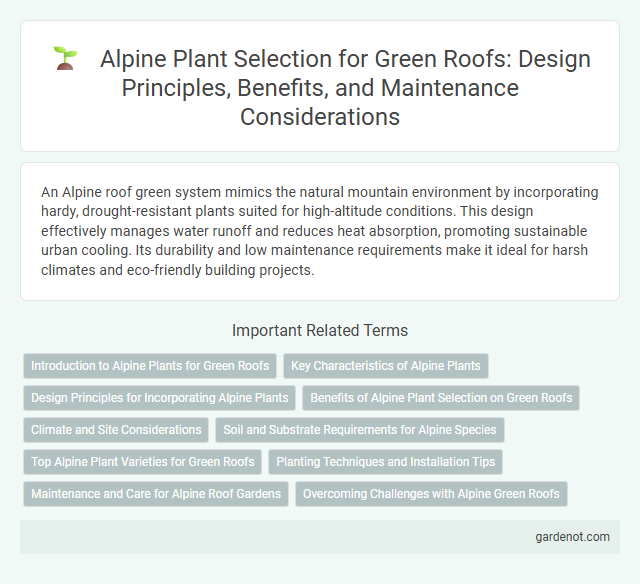An Alpine roof green system mimics the natural mountain environment by incorporating hardy, drought-resistant plants suited for high-altitude conditions. This design effectively manages water runoff and reduces heat absorption, promoting sustainable urban cooling. Its durability and low maintenance requirements make it ideal for harsh climates and eco-friendly building projects.
Introduction to Alpine Plants for Green Roofs
Alpine plants are ideal for green roofs due to their hardiness and ability to thrive in shallow, well-drained substrates with minimal nutrients. These plants include sedums, saxifrages, and alpine grasses, which exhibit drought tolerance and cold resistance, essential for rooftop ecosystems. Incorporating alpine species enhances biodiversity and promotes sustainable urban habitats in challenging environmental conditions.
Key Characteristics of Alpine Plants
Alpine plants used in green roofs exhibit exceptional drought tolerance and resilience to extreme temperature fluctuations, thriving in shallow, nutrient-poor substrates. Their low-growing, mat-forming habit reduces wind exposure and conserves moisture, making them ideal for high-altitude or harsh urban environments. These plants also possess strong root systems that aid in soil stabilization and enhance the overall durability of alpine green roof installations.
Design Principles for Incorporating Alpine Plants
Design principles for incorporating alpine plants on green roofs emphasize well-draining substrates and shallow soil profiles to mimic natural mountain conditions. Selecting drought-tolerant, low-growing species such as Sedum and Saxifraga ensures resilience in harsh alpine climates. Strategic placement for optimal sun exposure and protection from strong winds enhances plant establishment and long-term sustainability.
Benefits of Alpine Plant Selection on Green Roofs
Alpine plant selection on green roofs enhances biodiversity due to their adaptability to harsh, low-nutrient conditions, promoting resilient ecosystems that require minimal maintenance. These plants improve stormwater management by efficiently absorbing and retaining rainfall, reducing runoff and mitigating urban flooding. Their ability to thrive in shallow substrates also optimizes roof weight loads, making them ideal for sustainable, lightweight green roofing systems.
Climate and Site Considerations
Alpine green roofs require careful evaluation of local climate factors such as temperature extremes, wind exposure, and snow load to ensure plant survival and structural integrity. Site considerations include elevation, solar radiation intensity, and soil drainage capacity to support drought-tolerant and frost-resistant vegetation. Proper assessment of these elements enhances the sustainability and performance of alpine green roofing systems.
Soil and Substrate Requirements for Alpine Species
Alpine roofs require a specialized soil mix with excellent drainage and low nutrient content to mimic natural high-mountain environments. The substrate should be lightweight, porous, and well-aerated, often composed of gravel, sand, and organic matter to support alpine species' root systems while preventing waterlogging. Selecting a soil medium with a pH between 6.0 and 7.0 enhances nutrient availability and promotes the growth and resilience of alpine plants on green roofs.
Top Alpine Plant Varieties for Green Roofs
Top alpine plant varieties for green roofs include Sedum species, such as Sedum album and Sedum reflexum, known for their drought tolerance and low maintenance. Other popular choices are Sempervivum (hens and chicks) and Alpine saxifrage (Saxifraga oppositifolia), both thriving in harsh, exposed conditions. These plants provide excellent ground cover, enhance biodiversity, and improve the thermal efficiency of green roof systems in alpine and temperate climates.
Planting Techniques and Installation Tips
Alpine roofs require specialized planting techniques, including the use of drought-resistant alpine plants with deep root systems that ensure optimal water retention and soil stability. Installation tips emphasize proper substrate layering with well-draining materials like lightweight aggregate to prevent waterlogging while supporting plant health. Ensuring adequate insulation and secure edging is crucial for protecting the roof structure from harsh alpine weather and maintaining long-term system integrity.
Maintenance and Care for Alpine Roof Gardens
Alpine roof gardens require careful maintenance to support the specialized vegetation adapted to high-altitude conditions, emphasizing soil moisture regulation and protection from extreme weather. Regular inspection for drainage efficiency prevents root rot and ensures plant health, while occasional pruning promotes robust growth of alpine species such as sedums and saxifrages. Using lightweight, well-draining substrates and appropriate fertilization enhances the resilience and longevity of green roof systems in alpine environments.
Overcoming Challenges with Alpine Green Roofs
Alpine green roofs withstand extreme weather conditions by utilizing hardy, drought-resistant plant species like Sedum and Sempervivum, which thrive in shallow, rocky substrates. Innovative drainage systems and lightweight, insulating substrates are critical components to prevent waterlogging and root damage in high-altitude environments. Maintenance strategies focus on monitoring moisture levels and protecting the roof from frost heave to ensure long-term sustainability and energy efficiency.
Alpine roof Infographic

 gardenot.com
gardenot.com